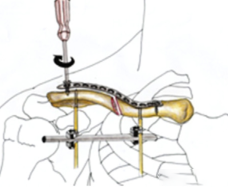-

The Magical Effect of Proximal Humeral Plate in Minimally...
The optimal management of distal humeral shaft fractures is technically challenging and controversial. One approach to surgical treatment is fixation with a reconstruction plate: A lateral approach is generally used for distal 1/3 fractures. Ho...Read more -

Classic Reappearance – Detailed Explanation of the ...
Minimally invasive surgery has become increasingly popular in recent years. Proximal humeral fractures can also be treated with MIPO technology. Minimally invasive plate osteosynthesis has been proven to be a safe and effective method. Anatomical ...Read more -

How to repair meniscus injury without a meniscus stapler?
A meniscal tear is one of the most common injuries of the knee. There are three main types of meniscal repairs. These include inside-out, outside-in, and all-inside repairs. Although a combination of these techniques can be used when repairing lar...Read more -

Fluoroscopic reduction during intertrochanteric fracture ...
Intertrochanteric fracture is the most common clinical hip fracture and one of the three major osteoporotic fractures in the elderly. Conservative treatment requires long-term bed rest, and the risk of bedsores, lung infection, pulmonary embolism,...Read more -

Do you understand these key points of MRI diagnosis of hi...
For patients with hip symptoms, MRI is of great significance for early diagnosis and treatment, and can provide anatomical details of the hip joint, including information about the bones, articular cartilage, and surrounding soft tissues that make...Read more -
Revisiting the Indications for Unicondylar Knee Replacement
Unicompartmental knee arthroplasty (UKA) is an effective treatment for unicompartmental arthritis (OA), which can significantly relieve knee pain and improve function. In 1989, Kozinn and Scott proposed the selection criteria for UKA. Since then, ...Read more -

What are the factors causing failure of internal fixation...
Intertrochanteric fractures of the femur are more common in the elderly, mostly caused by trauma, with the onset age being 66 to 76 years old. Treatment methods for intertrochanteric fractures are divided into two categories: conservative treatmen...Read more -

New Options for Treatment of Acromioclavicular Joint Disl...
Acromioclavicular joint dislocation is one of the most common injuries of the shoulder. It is more common due to direct violence and occurs more often in young people. The incidence rate accounts for about 12% of shoulder injuries. The Rockwood cl...Read more -

Henry Approach Volar Locking Plate Internal Fixation for ...
Distal radius fracture is the most common upper limb fracture, accounting for 1/6 of emergency fractures. It is more likely to occur in high-energy injuries in young patients or low-energy ground injuries in older patients. Volar Henry locking pla...Read more -

Schatzker And Hohl-Moore Classification Of Tibial Plateau...
Tibial plateau fractures are the result of strong valgus stress combined with axial loading. Literature statistics show that 55% to 70% of tibial plateau fractures are tibial lateral condyle fractures. At this point, the femoral condyle exerts she...Read more -

Surgical techniques for treatment of mallet finger with K...
Mallet finger results from flexion or hyperextension forces on the extended distal phalanx, with or without bony avulsion at the distal tendon insertion. According to the different degrees of distal finger joint avulsion, the classification (pict...Read more -

Minimally Invasive Plate Osteosynthesis (MIPO) for the Tr...
Currently, open reduction and plate fixation are conventional surgical methods for treating displaced midshaft clavicle fractures. However, these procedures carry risks of extensive soft tissue dissection, leading to complications such as neurovas...Read more -

Intramedullary Treatment of Intertrochanteric Fracture of...
Intertrochanteric fractures are a common orthopedic injury that imposes significant morbidity on patients and costs to the healthcare system. Surgical fixation is the main method of treatment. Surgery within 48 hours of injury reduces mortality. D...Read more -

2023 XC MEDICO AUTUMN TOUR TEAM BUILDING ACTIVITY
In the golden autumn of October, XC Medico organized a medium to long term team building activity. Destination: Lanzhou, China. The plane arrived at Lanzhou Airport, and we checked into the reserved hotel first. Then, a happy 5-day team building t...Read more -

Surgical Treatment of Distal Radius Fracture with Illustr...
Distal ulna fracture (DUF) is a common concomitant injury with distal radius fracture (DRF), and in most cases, it can be managed non-surgically without affecting functional outcomes. However, if there is instability in the distal radioulnar joint...Read more -

What Are The Precautions for Treating Ankle Fractures in ...
Ankle fractures are the third most common fracture in older adults, after hip and radius fractures. Ankle fractures themselves are not classic osteoporotic injuries. However, bimalleolar and trimalleolar fractures in older patients meet criteria...Read more -
1.jpg)
Is Distal Locking of Humeral Shaft Intramedullary Nail Ne...
The indications for intramedullary nailing of humeral shaft fractures have now been expanded because it is less invasive than plate fixation. However, there are multiple neurovessels in the distal humerus, and the anatomy is relatively complex. Di...Read more -

How to Diagnose and Treat Tibial Plateau Fractures
How to diagnose and treat tibial plateau fractures Tibial plateau fractures are one of the most common fractures, accounting for about 1.66% of systemic fractures. Tibial plateau fractures are complex injuries ...Read more -

Interfuse Interspinous Fixation System
- Ideal for the Treatment of Mild to Moderate Lumbar Degenerative Diseases Definition The interspinous process is fused and fixed, and the posterio...Read more -

Learning About OLIF Surgery
What is OLIF Surgery? OLIF(oblique lateral interbody fusion), is a minimally invasive approach to spinal fusion surgery in which the neurosurgeon accesses and repairs the lower (lumbar) spine from the front and...Read more
















1.jpg)


